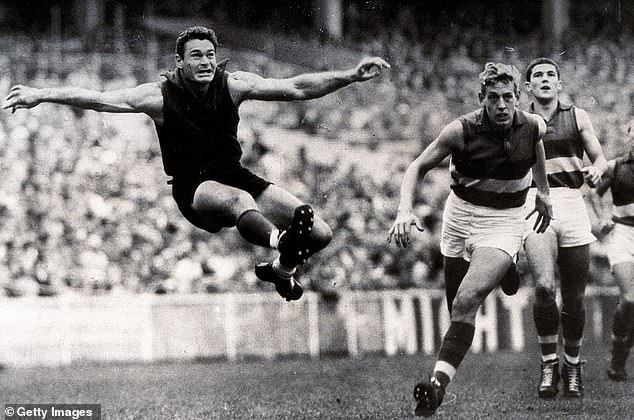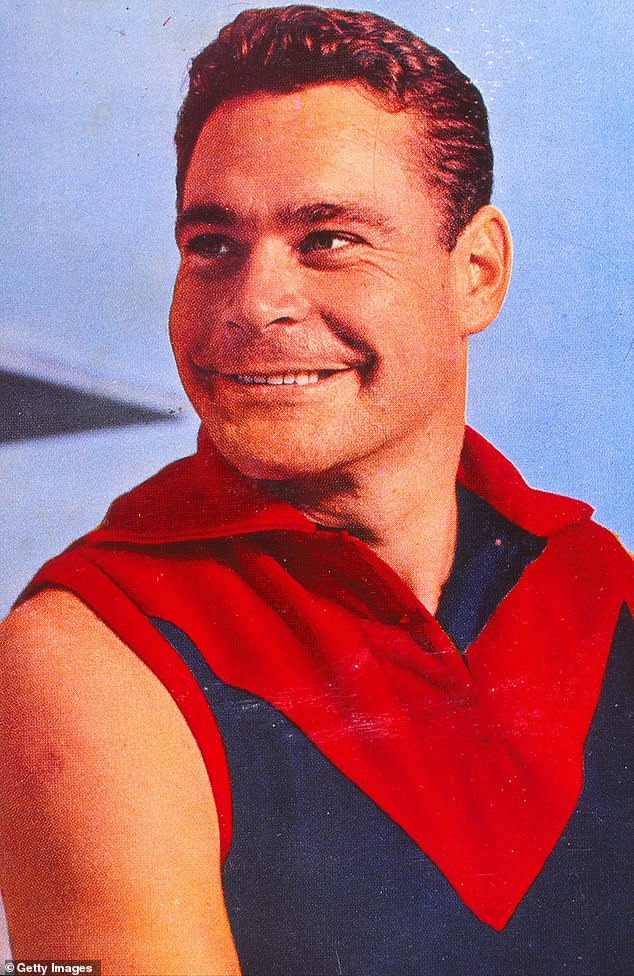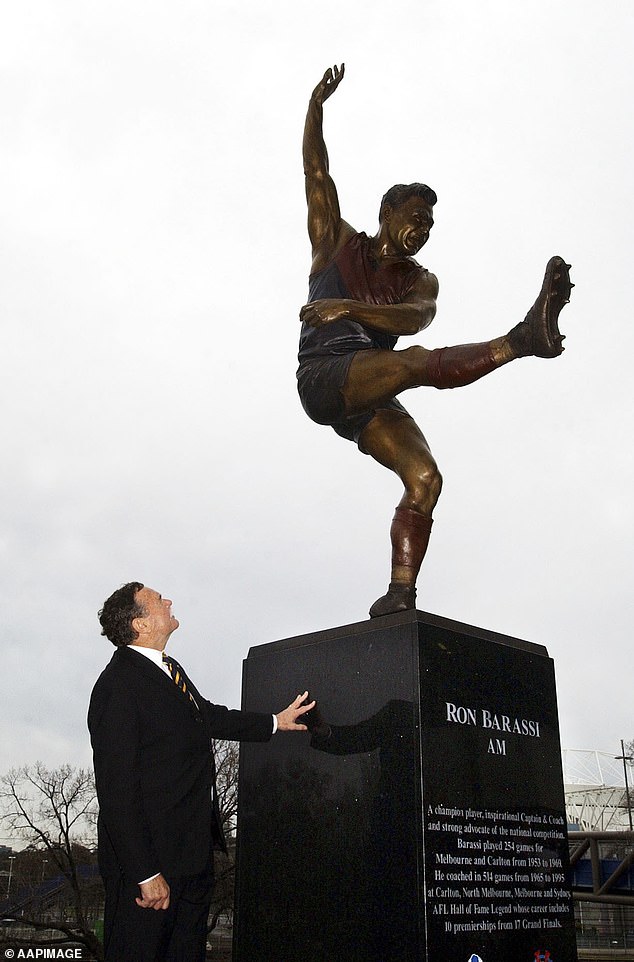Ron Barassi: AFL farewells a fearless hero both on and off the field
In the 1940s he was a fatherless Australian rules prodigy; in the 1950s he was one of the best players of the time; by the 1960s and 1970s he had become a coach known for colorfully abusing his players and winning premierships.
More recently, Ron Barassi is probably best remembered for chasing down a man he saw attacking a young woman in St Kilda and knocking him to the ground.
That was on New Year’s Eve 2008, when Barassi was 72 and almost capable of such noble deeds. He was eventually turned on himself and came away with broken ribs, several abrasions and a medal for bravery.
He had previously pulled a man from a burning car and lost his spleen in a previous car accident while coaching at North Melbourne. He didn’t even know until he read it in the newspaper. “Hero” hardly begins to do it justice.
Ronald Dale Barassi, who has died aged 87, was officially a legend of Australian football. One of the first football celebrities, he is also known as an innovator, an inspiring coach and a great player.
Ron Barassi, one of the best-known and beloved figures in AFL, has passed away at the age of 87. A minute’s silence was held at Adelaide Oval before Saturday night’s semi-final between Port Adelaide and Greater Western Sydney

Barassi was eating with his wife Cherryl and friends at a restaurant in St Kilda on New Year’s Day 2009 when a woman fell back onto his table after being punched. He chased the man but was then attacked himself
Barassi is best associated with the red and blue of Melbourne, where he played 204 games and won six premierships.
“The Melbourne Football Club is deeply saddened by the passing of one of its favorite sons,” the club wrote on social media.
Club CEO Gery Pert said the AFL has “lost a giant” but his “spirit and impact will live on in the game he loved so dearly”.
“His legacy will forever be etched in the history of the game.”
He went on to play and coach for Carlton and led them to a premiership in 1968, their first in more than twenty years.
Carlton president Luke Sayers said Friday night’s semi-final between Melbourne and Carlton “symbolized” the great man and the AFL was “privileged” to have him.
North Melbourne, where he subsequently continued his coaching career and won the club’s first two premierships in 1975 and 1977, said they remembered with “heavy hearts” a “football icon”.
Brendan Gale, the CEO of Richmond – a club he turned down to make a bid for the Blues – said what Barassi did before the match could not be overstated.
“On behalf of Richmond FC, I extend my condolences to the family, friends and fans of Ron Barassi.
“A true giant of the game, Ron’s impact on the AFL and Australian Rules Football in general is immeasurable, and he will be greatly missed. Rest in peace.’
Former St Kilda defender and Fox Footy expert Leigh Montagna said Barassi was perhaps the ‘most iconic name in our sport’.
Victorian Opposition Leader John Pesutto said Barassi was a “titan of Australian Rules Football whose influence spanned generations and inspired millions of people over the decades.”
Commentator Rohan Connolly added: ‘Ronald Dale Barassi was not only a champion player and master coach, he was an innovator, a deep thinker and an inspiring leader.
“He was also a wonderful, smart and funny man. Few people will leave as big a mark on Australian football as he did. RIP Ron, and thank you.”
Prime Minister Anthony Albanese paid tribute to Barassi, saying there is no better known name in football.
AFL chairman Richard Goyder called him the game’s most important figure since World War II.

Barassi went from on-field prodigy to premiership-winning coach over a career spanning four decades (pictured in 1964)
Born in Castlemaine, Victoria, to Ron Barassi Snr and his wife Elza, Barassi was destined to follow his father to the Melbourne Football Club.
Ron Snr played 58 games for the Demons and was part of Melbourne’s 1940 premiership.
Within days of winning that grand final, he enlisted in the army and was sent to North Africa, where he was killed at Tobruk in July 1941, aged 27.
The football club agreed to care for five-year-old Ron junior and his mother and from the age of 16 he lived in a bungalow in the backyard of legendary Melbourne coach Norm Smith.
Although Barassi was inextricably linked to Melbourne, the zoning rules at the time gave Collingwood and Carlton the right to recruit him.
Melbourne duly lobbied the VFL and Barassi became the first player to fall under what became known as the father-son rule.
For example, as a 17-year-old in 1953, Barassi played his first senior VFL match for the Demons against Footscray.

Barassi quickly became one of the best players of the 1950s and 1960s
Within four years he had become vice-captain of the club and took over the captaincy in 1960, the same year in which he and Melbourne claimed their fifth premiership in six years.
After 204 games in Melbourne, Barassi shocked the sport by accepting an offer to become Carlton captain-coach in 1965. He played five seasons and 50 games for the Blues, completing premierships in 1968 as games coach and in 1970 as coach.
Barassi retired from football after the 1971 season to concentrate on setting up his office furniture business, returning two years later for perhaps the most colourful, controversial and successful period of his coaching career at North Melbourne.
In 1973, North were the only club in the then VFL not to have won a premiership.
They had finished bottom of the ladder with one win for the 1972 season.
But club chairman and former player Allen Aylett and secretary Ron Joseph decided to do something about it and devised a plan to win a premiership within five years.
Central to their plan was ‘purchasing’ as many top players as possible and getting Barassi to coach them.
Thanks to the introduction of a new and short-lived rule regarding player transfers, Joseph ‘bought’ the core of a new team, his recruits including three VFL captains, Barry Davis from Essendon, John Rantall from South Melbourne and Doug Wade from Geelong. .
The buying frenzy also attracted star players such as Malcolm Blight and Barry Cable.
In the first year under Barassi, North finished sixth and in 1974 they finished second, beaten by Richmond in the grand final.
The breakthrough came the following year, when Barassi engineered a 55-point victory over Hawthorn in the decider.
The champions team of Barassi and North repeated the attempt in 1977, winning the club’s second flag after drawing against Collingwood in the first grand final and winning by 27 points in the replay a week later.
The win capped one of the game’s great careers.

Barassi stands next to a bronze statue of himself that was unveiled outside the MCG in 2003. The statue, by Louis Lauman, is number 3 of 10 commissioned as part of Tattersall’s $1 million ‘Parade of the Champions’
Barassi subsequently had brief coaching spells at Melbourne and Sydney and cemented his reputation as one of the game’s great visionaries through his ‘Irish Experiment’ in which he recruited several players from Gaelic football to Australian Rules, including Demons’ champion Jim Stynes.
His tenth major final victory also led to Barassi coining the trademark 17410 – 17 grand finals for 10 premierships – which, along with the number 31 of his football shirt, always accompanied his signature.
In 1996, Barassi became an inaugural inductee into the Australian Football Hall of Fame, entering that pantheon as a ‘legend’ and in 2006 he became only the third Australian Rules footballer, along with Leigh Matthews and Ted Whitten, to be inducted into the Sport Australia Hall of Fame. Fame.
This week Bob Skilton became fourth.
Barassi was named Victorian of the Year in 2009 and is commemorated in a life-size bronze statue outside Gate 4 of the MCG.
In 2012, at the age of 76, he revealed in typically good humor that he had dementia.
“I’m forgetful,” Barassi said. “It’s not a concern.”
Barassi married twice, first to Nancy Kellett in 1957, with whom he had Susan, Ron and Richard; and to Cherryl Copeland in 1981.
